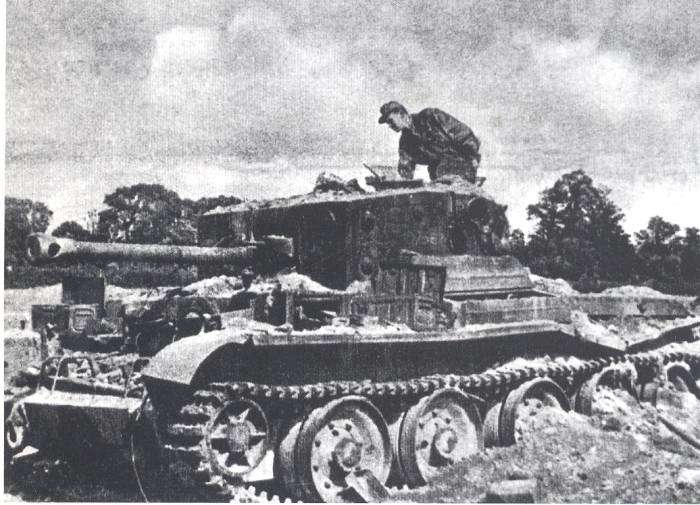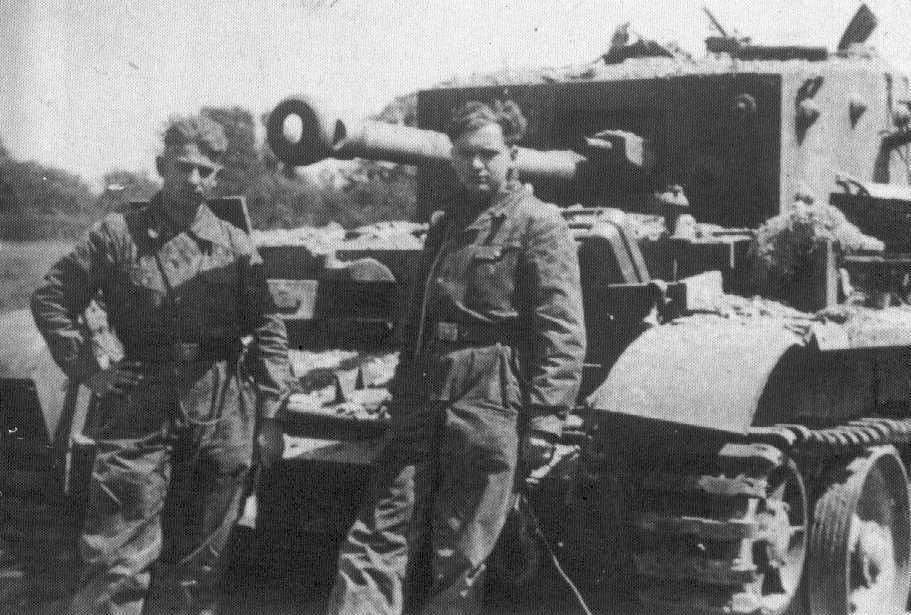Saxon Cross wrote: Penetration ranges against Pz VI for each gun (ammunition not specified) are stated as being 800 yards for 6-pdr on the front, 1600 yards on the side, and 2000-2500 yards for the 17-pdr.
Post-battle reports from men on both sides, suggest those numbers are sadly overoptimistic ...
13th June 1944. Villers Bocage, FRANCE - “… An officer at Villers Bocage, Bernard Rose, reported his 6-pdr shots bouncing off Wittmann’s tank {Tiger of SS-Heavy Tank Battalion 101] at a range of eight—repeat ‘eight’ yards …”
Ken Tout.
A Fine Night for Tanks: The Road to Falaise.
©1998 Sutton Publishing, see p.134
13th June 1944. Villers Bocage, FRANCE - “… Wittman continued along the main street of Villers Bocage … then, when he arrived in his Tiger at the Place Jeanne d’Arc, the lead tank of ‘B’ Squadron of the 4th CLY, a Sherman Firefly commanded by Sergeant Stan Lockwood, was waiting for him. On seeing the Tiger, 200 metres away, with its turret traversed to fire into a side street, the latter fired four 17 pdr. shells at it. One of them hit the hull, producing a jet of flame. Wittmann replied by bringing half a house on top of the Sherman, but assuming the presence of other tanks turned round, his Tiger hardly damaged …”
Georges Bernage.
The Panzers and the Battle of Normandy: 5 June to 20 July 1944.
©2000 Editions Heimdal, see p.88.
18th July 1944. Cagny, FRANCE - “… The lethality of the four Luftwaffe 88s is reinforced by the fact that they also accounted for the only two Tigers in the 3rd Company’s [Heavy Tank Battalion 503] defensive position that were lost throughout the day. These Tigers were penetrated in their frontal armor while they were repositioning around a small wooded area. The Luftwaffe gunners, understandably weak in armored fighting vehicle identification, mistook them for British tanks. Even at the range of 1,200 meters, the Luftwaffe 88mm antiaircaft guns were able to penetrate the Tigers’ frontal armor …”
Christopher Wilbeck.
Sledgehammers: Strengths and Flaws of Tiger Tank Battalions in World War II.
©2004 Aberjona Press, see p.123.
Hit probability is therefore regarded as a more important limitation on maximum engagement range than penetration
The author should have noted that engagment range is also a critical factor in correct identification of the target, and the perceptions of any real or imagined damage caused to said target.
Another limitation—which was largely ignored in this thread—is training, or lack of it. When the Northhamptonshire Yeomanry received tasking for Operation
Totalize in August 1944, some of the Firefly crews had never once fired the main gun, in battle or in the training camps before D-Day:
“ … As D-Day approached, one of the minor problems was that encountered by gunners of the immensely long Firefly 17-pdr gun. The gun sights needed to be tested and set. This was done by sighting an object about 1,500 yd away and using it as an aiming mark at the gun’s optimum range. Joe Crittenden found great difficulty in locating a target because of the press of vehicles which screened off almost any object 1,500 yd away and also made traversing of the turret with its long gun a hazard both to the gun and its neighbours. The Firefly itself was something of a ‘sophisticated’ element very recently introduced. Joe Ekins, lining up on his sighting mark, had only fired the gun once in England, it being a ‘secret weapon’ and not available in mass numbers. He had been astonished by the muzzle flash, which almost wrapped itself around the turret and virtually blinded gunner and commander. Combined with the dense smoke produced, observation of fall of shot was difficult until gunner and commander learned to keep their eyes shut for the fraction of a second while the gun fired. Since landing in Normandy in June, Joe’s tank had not been required to fire a shot—such chances occur in the vagaries of tank warfare. So he was preparing to go into a crucial action with only one firing practice on his record. Some other Firefly gunners had not yet fired a round …”
It’s amazing that some amateur/apprentice gunlayer could hit anything beyond 500 yards, let alone live up to your paper figures about hit probability.
Ken Tout.
A Fine Night for Tanks: The Road to Falaise.
©1998 Sutton Publishing, see p.41-42
it is noted that tanks are very unlikely to survive penetrations by projectiles of 6-pdr size and greater
This is another terrible exaggeration. Many knocked out tanks and tank destroyers were recovered by salvage crews, and repaired.
I know that many wargamers are slaves to these range tables. It’s a mistake. Anyone with a modicum of common sense knows that anti-tank gunners (whose lives were at stake) were more inclined to seek information from other gun crewmen, by after-action reports and tactical briefings.
The original document emphatically stresses the approxmate nature of these results, and cautions that they should be treated as comparative rather than absolute figures.
That statement sounds just like a weather forecast with a 50% chance of rain.

The 6-pdr and 17-pdr guns have been way over-rated by the British propaganda machine. The quality and performance of German ammunition, their low-flash, low-smoke propellent charges, and their sighting equipment were never matched by the British Army.







